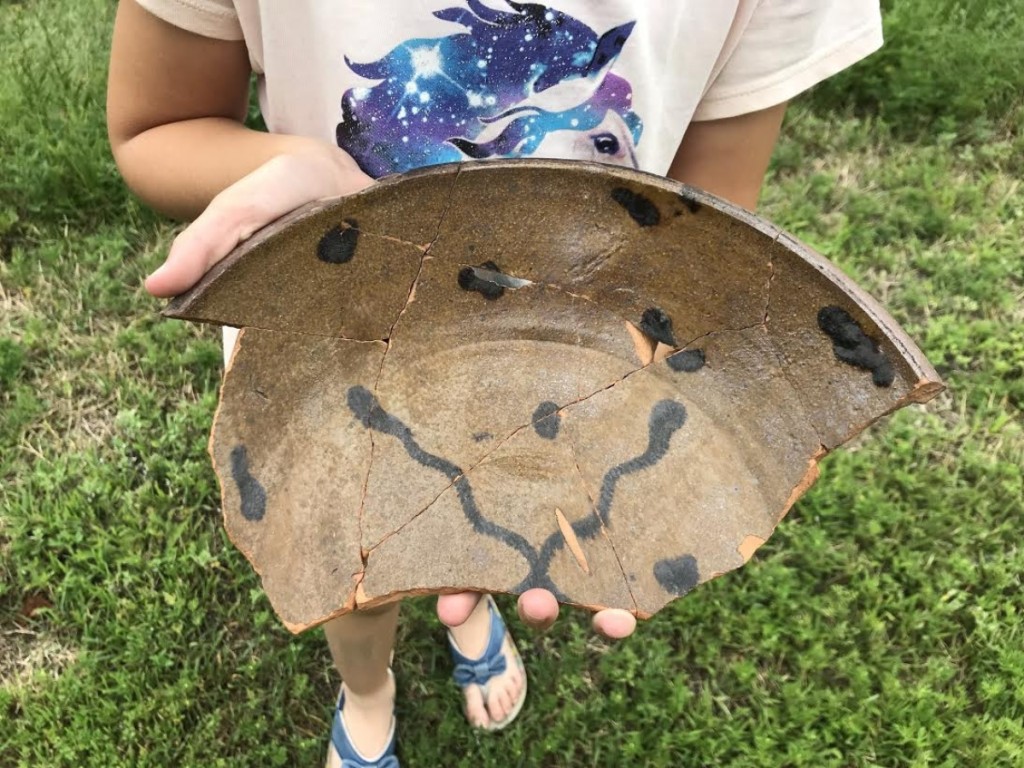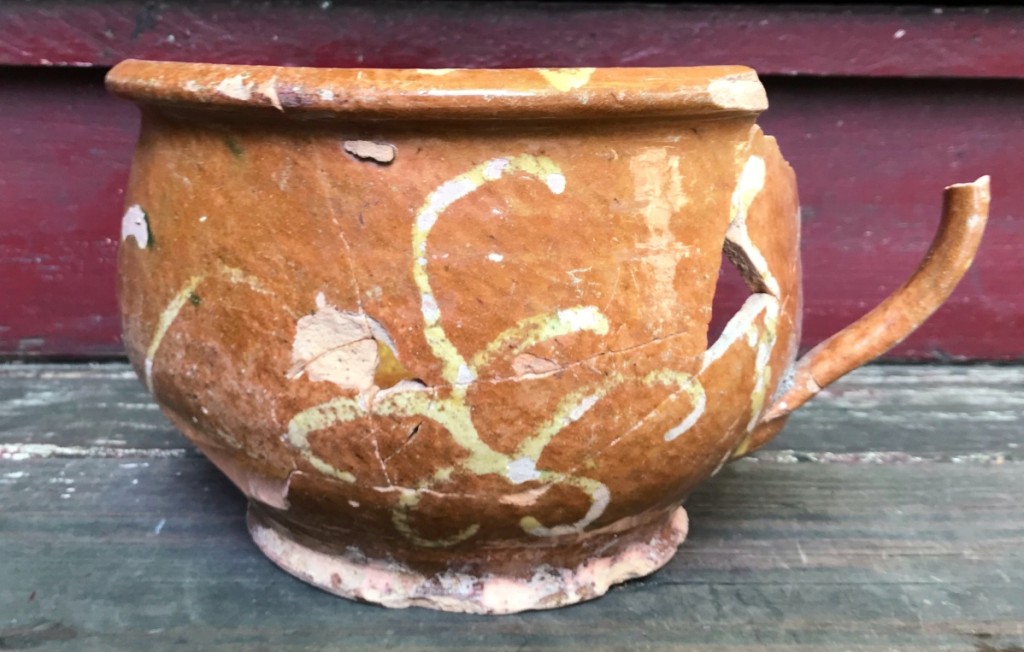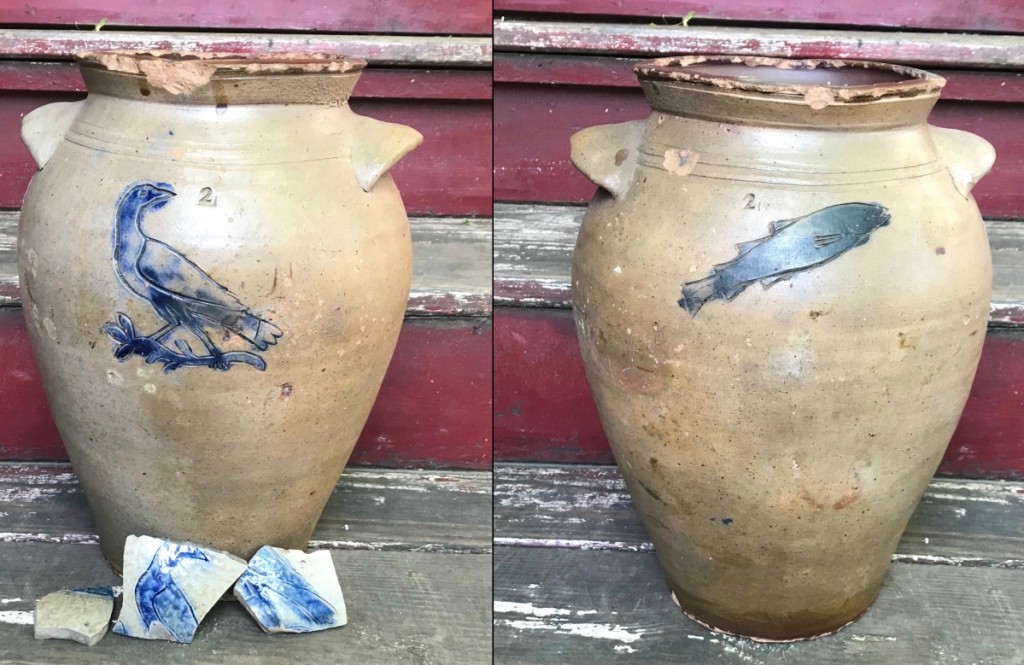
This pan was likely made at the Daniel Bayley Pottery Company in Newburyport and recovered at the bottom of a well at 369 Court Street in Portsmouth, N.H.
By Rick Russack
NEWBURYPORT, MASS. – Running through April 30, 2020 at the Custom House Maritime Museum in Newburyport, is a comprehensive exhibition titled “Potters on the Merrimac: A Century of New England Ceramics.” This exhibition will focus on early American pottery production in Merrimacport, Mass., from 1790 to 1890, with a focus on the William Pecker pottery (circa 1790-1820), and the Daniel Bayley Pottery Company in Newburyport (circa 1764-1799). It will cover most of the local pottery production before and after the American Revolution.
More than 75 pieces, made by several different potters will be included in the exhibition, as well as material recovered from archeological digs at pottery sites and large construction projects. Identification of pottery made in the Merrimack River region is difficult, so this exhibit will provide a guide for those interested in pottery produced there. The curatorial team of the Custom House Maritime Museum, along with guest curator Justin Thomas, have assembled the exhibit, a first for the Custom House.
Many of the pieces are returning to the Newburyport area two centuries after dispersal, first to consumers needing the pottery, and later to collectors appreciating the pottery for its beauty and for what it tells us about production and distribution in pre-industrial revolution America.
Utilitarian, lead-glazed earthenware had been a household necessity in New England since the earliest days of Seventeenth Century settlement. Domestic production of these everyday ceramic wares began not long after the Massachusetts Bay Colony was established in 1630. This local production helped fulfill the needs of the inhabitants of the colony, which otherwise could only partially be fulfilled by items coming from England. As with all such items of manufacture, these locally made objects were also used in trade and commerce, and, over time, they became staples of the local economy and were traded as far as they could be carried, both by land and ship. In Essex County, Mass., on the banks of the Merrimack River, generations of families produced these ceramic vessels of varying dimensions and purpose, with varying glazes and decorations, utilizing local clay deposits to meet the needs of their neighbors and earn money to meet the needs of their own families. They built workshops, warehouses, kilns and homes, which they passed on to the next generation, along with the knowledge of their craft.
Much of the material will be presented in a context that has not been possible before. Several institutions have loaned important items, including Historic New England, the Lura Woodside Watkins collection at Old Sturbridge Village, the Museums of Old York, about a dozen other institutions and items from the collection of co-curator Justin Thomas.

Slip-decorated chamber pot attributed to the Daniel Bayley Pottery Company. Recovered in Eighteenth Century contexts in Portsmouth, N.H. Courtesy Strawbery Banke archaeology department.
Watkins was the first to seriously study New England redware and published Early New England Potters and Their Wares in 1950, a book still considered the “bible” for those interested in New England pottery. Of particular interest for students of colonial redware will be the number of items dug from known archaeological sites. Some from the site of the potter’s works, some from privies in the area, and some from large scale excavations such as Boston’s “Big Dig.” The archaeological specimens will show the distribution of wares made by the Bayley family, who were located in Newburyport, to other towns, some as far away as Salem, Mass., and Portland, Maine.
An important example of Bayley’s redware on display is a jug that was made for Oliver Noble’s church in Newburyport (which at the time was still a part of Newbury). Noble became minister of the church on September 1, 1762 and this jug is inscribed “For the Use of Mr Noble’s Church, July 10, 1763.” There are the remains of slip-decorated chamber pots, bowls and a slip-script pan dated “1770” (recovered in Historic Westbrook, Maine), among other artifacts. Four pieces of Bayley pottery were bought at a single-owner John McInnis auction in Newbury last year (See the July 20, 2018 edition of this publication for a full report of that auction). Nearly everything in the house was early and Thomas believes that the four pieces may have been bought by the early owners of the house directly from the Bayley pottery.
Another focus of the exhibition will be the pottery of William Pecker, Merrimacport, Mass., who was known as a traditional redware potter, and numerous examples of his redware will be on display. But he also produced stoneware, few examples of which have been seen. Only about 15 examples of Pecker’s stoneware are known and about one third of those will be on display, along with shards recovered in the last few years at the site of the pottery.
Never a focus of an exhibit until now is the Grecian-style wares made at the Merrimac Pottery Company in the 1890s and early-1900s. Many of these wares were inspired from pieces in the Museum of Fine Arts, Boston. One of the more notable examples is a two-piece urn with elaborate decoration that was acquired by the Museum of Old Newbury in brand-new condition in the early-1900s. Thomas stated, “To my knowledge, it has never been displayed outside of the museum before. I don’t know of another piece like this that survives today.”
The redware exhibit is co-curated by Custom House Maritime Museum curator Kevin MacDonald and guest curator Justin Thomas. A collector and researcher of redware, Thomas had the genesis idea and wrote the catalog for the exhibition, noting that small museums and historical societies he visited often had collections of locally made pottery, but that Newburyport, his home town, did not. Thomas, editor of the CBS Boston weekday morning show, spends most of his time seeking redware for his collection and researching primary source material about the makers. His knowledge of form and glaze color allow him to identify much of the redware he comes across.

William Pecker attributed stoneware crock with impressed bird on one side and impressed fish on the reverse side, together with a sherd impressed with the same bird recovered at the site of the Pecker Pottery.
Thomas’ interest began in 1999 when his father came home with an Essex county redware jug purchased at a local flea market. He began going to flea markets himself, as well as local auctions, and by 2011 was a serious collector. His interests have taken him beyond New England to visit museums, collectors and dealers in New York, Pennsylvania and beyond often with his niece and nephew. He posts newly discovered information and new pieces being added to his collection on his blog at www.earlyamericanceramics.com.
The Custom House Maritime Museum is housed in a stone building with its materials quarried in nearby Rockport, Mass. It dates back to 1835 and was designed by Robert Mills, designer of the first Washington Monument in Baltimore as well as the one in Washington, DC, and the US Treasury building and others. Some claim that Mills was the first native-born American to be trained as an architect, although most would give that distinction to Charles Bullfinch. Mills was an early designer of fireproof buildings and even the staircase in this building, as well as the floors, are constructed without wood.
Formerly known as the United States Customhouse it functioned as the base of operations for customs collections along a large portion of the New England coast, with revenue cutters to supervise shipping, as well as the collection of taxes and duties from outgoing and incoming ships. Revenue cutters also intercepted ships involved in the slave trade. It was the farthest north of the four customs houses at that time and served the area from Portsmouth to Salem.
Newburyport was a major shipbuilding town, on a par with both Portsmouth and Salem. The first revenue cutter, the Massachusetts, a two masted schooner, was built in Newburyport in 1791 and saw service out of Boston but was only in service for little more than a year. Newburyport was also the base of operations for famed shipbuilder Donald McKay who developed the high-speed clipper ships involved in the China trade. For the last nine years, Kevin MacDonald has been the curator of the museum, a volunteer position. The museum’s collections relate to the maritime history of Newburyport and include a number of ship models, fine marine paintings, photos and information regarding shipwrecks – some well-known and some not.
Most importantly, the museum displays artifacts relating to the Coast Guard and its predecessor, the United States Life Saving Service, which was created in 1848 to aid shipwrecked mariners. The museum maintains a comprehensive research library of materials relating to the history of the Coast Guard, shipwrecks and Newburyport’s shipbuilding past. It was opened in 1975, at a time when urban renewal was changing the face of downtown Newburyport, and the decision was made to retain this building. They coordinate with the Historical Society of Old Newbury, just a few blocks away, in order to avoid duplication of collecting efforts. Both are well worth a visit.
The Custom House Maritime Museum is closed on Mondays. For more information, 978-462-8681 or https://customhousemaritimemuseum.org
Further reading in this issue!
A History Of Pottery Production Along The Merrimack River

_urn_close_up_cap_fotor.jpg)





_see_cap_fotor.jpg)







